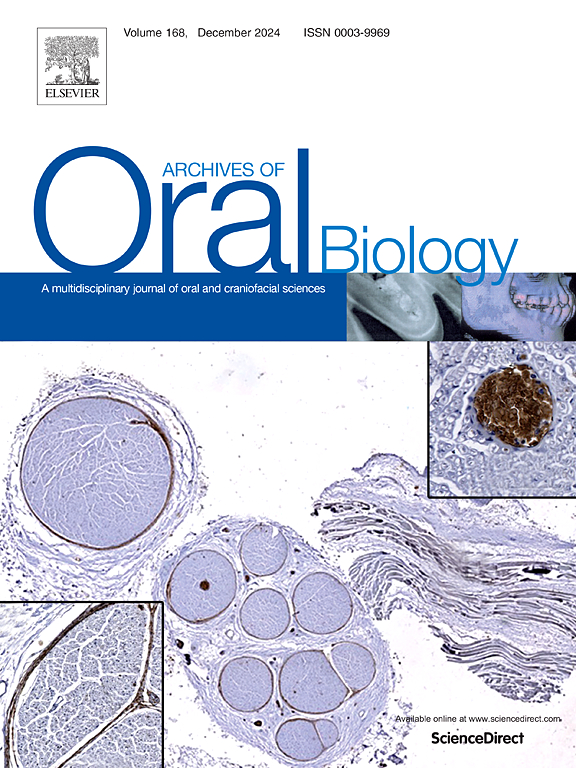Role of Fusobacterium nucleatum in the pathogenesis of oral squamous cell carcinoma: A systematic review of molecular mechanisms and signalling pathways
IF 2.1
4区 医学
Q2 DENTISTRY, ORAL SURGERY & MEDICINE
引用次数: 0
Abstract
Objectives
To evaluate the mechanisms and signalling pathways involved in the pathogenesis of oral squamous cell carcinoma (OSCC) that are promoted by Fusobacterium nucleatum infection across human participant, in vivo and in vitro studies.
Design
This systematic review was conducted in accordance with the PRISMA guidelines to address the question: What mechanisms and potential signalling pathways are implicated in the pathogenesis of OSCC facilitated by F. nucleatum infection, compared with non-infected controls? Searches were performed across three electronic databases: Scopus, Web of Science, and MEDLINE.
Results
Sixty-three studies met the inclusion criteria for the systematic review. Studies involving human participants revealed alterations in bacterial genes related to lipopolysaccharide (LPS) synthesis, bacterial mobility and flagellar assembly. Additionally, alteration in host genes including DNA repair, tumour protein P53 (TP53), toll-like receptors and proinflammatory genes such as interleukin (IL)1β, IL8, and IL6 were reported. In vivo studies reported upregulation of cyclin D1 and IL6 following F. nucleatum infection. In vitro studies demonstrated changes in epithelial-mesenchymal transition markers such as E-cadherin, N-cadherin, vimentin, and zinc finger E-box binding homeobox (ZEB)1/2, along with increased expression of inflammatory markers, including IL-8 and IL-6 following F. nucleatum infection.
Conclusion
The findings from this systematic review highlight a significant molecular response to F. nucleatum infection in oral cancer. The results underscore the complex interaction between F. nucleatum and host molecular pathways, offering valuable insights into how this bacterium may contribute to oral cancer development and progression.
核梭杆菌在口腔鳞状细胞癌发病机制中的作用:分子机制和信号通路的系统综述
目的探讨口腔鳞状细胞癌(OSCC)的发病机制和信号通路,探讨口腔鳞状细胞癌(OSCC)在人体内和体外研究中受核梭杆菌感染的影响。根据PRISMA指南,本系统综述旨在解决以下问题:与未感染对照相比,核胞梭菌感染诱发OSCC的发病机制和潜在信号通路涉及哪些机制和潜在信号通路?通过三个电子数据库进行搜索:Scopus、Web of Science和MEDLINE。结果63项研究符合系统评价的纳入标准。涉及人类参与者的研究揭示了与脂多糖(LPS)合成、细菌流动性和鞭毛组装相关的细菌基因的改变。此外,宿主基因的改变包括DNA修复、肿瘤蛋白P53 (TP53)、toll样受体和促炎基因,如白细胞介素(IL)1β、IL8和IL6。体内研究报告了核胞梭菌感染后细胞周期蛋白D1和il - 6的上调。体外研究表明,上皮-间质转化标记物如e -钙粘蛋白、n -钙粘蛋白、vimentin和锌指E-box结合同源盒(ZEB)1/2的变化,以及炎症标记物,包括IL-8和IL-6的表达增加。结论本系统综述的研究结果强调了口腔癌对具核梭菌感染的显著分子反应。结果强调了核梭菌与宿主分子途径之间复杂的相互作用,为这种细菌如何促进口腔癌的发展和进展提供了有价值的见解。
本文章由计算机程序翻译,如有差异,请以英文原文为准。
求助全文
约1分钟内获得全文
求助全文
来源期刊

Archives of oral biology
医学-牙科与口腔外科
CiteScore
5.10
自引率
3.30%
发文量
177
审稿时长
26 days
期刊介绍:
Archives of Oral Biology is an international journal which aims to publish papers of the highest scientific quality in the oral and craniofacial sciences. The journal is particularly interested in research which advances knowledge in the mechanisms of craniofacial development and disease, including:
Cell and molecular biology
Molecular genetics
Immunology
Pathogenesis
Cellular microbiology
Embryology
Syndromology
Forensic dentistry
 求助内容:
求助内容: 应助结果提醒方式:
应助结果提醒方式:


